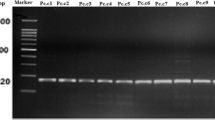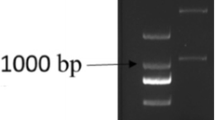Summary
Erwinia carotovora var.atroseptica could be detected in potato stems and potato tubers serologically and distinguished fromErwinia carotovora var.carotovora in double gel-diffusion tests. In sap squeezed from diseased stems and rotted tubers the pathogen could be detected. From detection of the latent infection tubers were treated according to the method of Pérombelon to increase the number of bacteria. These bacteria were detected serologically, either directly in the rotted tissue or, more reliably, after growing on agar. Compared with bacteriological techniques serological detection is a more reliable and less time-consuming method.
Zusammenfassung
Um eine schnelle und zuverlässige Methode zur Feststellung der Schwarzbeinigkeit an Kartoffelpflanzen und-knollen, die durchErwinia carotovora var.atroseptica verursacht wird, zu erhalten, wurde ein Antiserum gegen diesen Krankheitserreger hergestellt. In Agglutinationstest reagierte dieses Antiserum nicht spezifisch, aber im Agar-Doppeldiffusionstest konnte eine spezifische Reaktion erzielt wer den, wenn das Antiserum zuerst mitErwinia carotovora var.carotovora, einem Isolat, das serologischeng verwandt ist mitE. carotovora var.atroseptica, absorbiert wurde (Abb. 1 und Tabelle 1). Im ausgepressten Saft von befallenen Stengeln und faulen Knollen aus dem Feld konnte der Krankheitserreger direkt festgestellt werden. Um das Vorhandensein latenter Knolleninfektion zu zeigen, wurden verschiedene Methoden verglichen (S. 4). Da mit der Methode 3, die darauf beruht, dass die Knollen unter anaeroben Bedingungen gehalten werden, der höchste Prozentsatz an infizierten Knollen festegestellt wurde, kam diese in den weiteren Versuchen zur Anwendung. Beim Vorkommen von Nassfäule konnten zwei Vorgehen angewendet werden. Diese zwei Verfahren wurden mit der bakteriologischen Methode verglichen (Tabelle 2).
-
1.
Eine Suspension der faulenden Kartoffeln wurde auf Pektat-Agar-Nährboden gebracht. Nach zwei Tagen wurden die Bakterien von den Platten abgespült und serologisch getestet.
-
2.
Die Fäulnis wurde von den Kartoffeln weggespült, zentrifugiert und das Sediment, in etwas Wasser aufgenommen, ebenfalls serologisch getestet. Methode 1 was am zuverlässigsten, aber sic beanspruchte mehr Zeit und Arbeit. Ein Kompromiss könnte erzielt werden, wenn man die faulenden Knollen nach der Methode 2 untersucht und nachher eine Oese mit der negativ reagierenden Sedimentsuspension in den Agar bringt und diese dann nach der Methode 1 testet.
Résumé
On a préparé un antiserum contreErwinia carotovora, var.atroseptica dans le but d'obtenir une méthode rapide et fiable de détection de la jambe noire dans les plantes de pomme de terre et les tubercules. Cet antiserum ne réagit pas spécifiquement dans les tests d'agglutination mais on peut obtenir une réaction spécifique dans les tests de double diffusion dans l'agar quand l'antiserum est d'abord absorbé par l'isolat d'Erwinia acrotovora var.carotovora, étroitement apparente sérologiquement àE. carotovora var.atroseptica (fig. 1 et tableau 1). Le pathogène peut être détecté directement par pressurage de jus de tiges infectées et de tubercules pourrisants dans les champs. On a comparé diverses méthodes pour établir l'existence d'infection latente des tubercules. Puisque la méthode 3, basée sur la mise des tubercules en conditions anaérobies, détectait le plus haut pourcentage de tubercules infectés, elle a été utilisée dans les expériences ultérieures. Deux procédés peuvent être utilisés quand apparaît la pourriture molle. Ces deux procédés sont comparés à la méthode bactériologique (tableau 2).
-
1.
Une suspension de pommes de terre pourrissantes est étendue en raies sur milieu pectateagar. Après deux jours les bactéries sont recueillies par rinçage des plaques et testées sérologiquement.
-
2.
La pourriture des tubercules est rincée, centrifugée et la pelote prélevée dans un peu d'eau est également testée sérologiquement. La méthode 1 est plus fiable mais prend plus de temps et de travail.
On peut réaliser un ompromis en testant les tubercules pourrissant avec la méthode 2 et après cela étendant en raies dans l'agar un prélèvement à l'aiguille d'une suspension de pelote de ceux réagissant négativement pour le tester suivant la méthode 1.
Similar content being viewed by others
References
Fox, R. T. V., 1971. The ultrastructure of potato tubers infected by the soft rot organismErwinia carotovora var.atroseptica. Proc. 3rd. Int. Conf. Pl. pathogenic Bacteria (Wageningen, The Netherlands).
Goto, M. & N. Okabe, 1957. Studies on the strains ofErwinia carotovora (Jones) Holland. IV. Antigenic variations.Bull. Fac. Agric. Schizuoka Univ. 7: 11–12.
Goto, M. & N. Okabe, 1958. Studies on the strains ofErwinia carotovora (Jones) Holland. V. Antigenic structures of soma, their relation to biochemical properties, and heat inactivation of agglutination.Bull. Fac. Agric. Schizuoka Univ. 8: 1–3.
Graham, D. C., 1963. Serological diagnosis of potato blackleg and tuber soft rot.Pl. Path. 12: 142–144.
Lazar, L., 1971. Investigations concerning preparation of anti-Erwinia sera on rabbits.Proc. 3rd Int. Conf. Pl. Pathogenic Bacteria, (Wageningen, The Netharlands).
Lazar, L., 1971. Serological relationships between the amylovora, ‘carotovora’ and ‘herbicola’ groups of the genusErwinia. Proc. 3rd int. Conf. Pl. Pathogenic Bacteria (Wageningen, the Netherlands).
Lucas, L. T. & R. C. Grogan, 1969. Serological variation and identification ofPseudomonas lachrymans and otherPseudomonas nomenspecies.
Noble, M. & D. C. Graham, 1956. A selective medium for the isolation of coliform soft rot bacteria from plant tissue.
Nokava, J., 1957. A new method of isolation of blackleg pathogens from diseased plants.Phytopath. Z. 29: 72–74.
Pérombelon, M. C. M., 1971. A quantitative method for determining numbers ofcarotovora andatroseptica in soils and plant meterial.J. Appl. Bact. 34: 793–798.
Pérombelon, M. C. M., 1971. A semi selective medium for estimating population densities of pectolyticErwinia spp. in soil and plant material.Eur. Potato. 14: 158–161.
Pérombelon, M. G. M., 1972. A reliable and rapid method for detecting contamination of potato tubers byErwinia carotovora.Pl. Dis. Reptr. 56: 552–554.
Slogteren, D. H. M. van, 1972. Serology. In: J. A. de Bokx (Ed.), Viruses of potatoes and seedpotato production. Pudoc, Wageningen.
Tanii, A., A. Ozaki & T. Baba, 1973. Blackleg of potato plant caused byErwinia atroseptica (van Hall) Jennison (E. carotovora var.atroseptica (van Hall) Dye) in Japan.Ann. phytopath. Soc. Japan 39: 351–360.
Author information
Authors and Affiliations
Rights and permissions
About this article
Cite this article
Vruggink, H., Maas Geesteranus, H.P. Serological recognition ofErwinia carotovora var.atroseptica, the causal organism of potato blackleg. Potato Res 18, 546–555 (1975). https://doi.org/10.1007/BF02365679
Accepted:
Issue Date:
DOI: https://doi.org/10.1007/BF02365679




